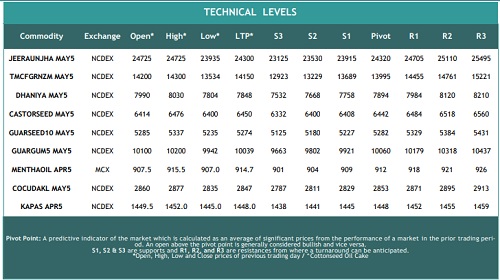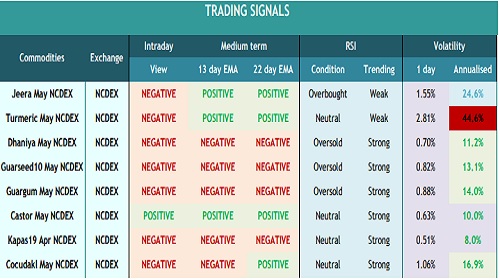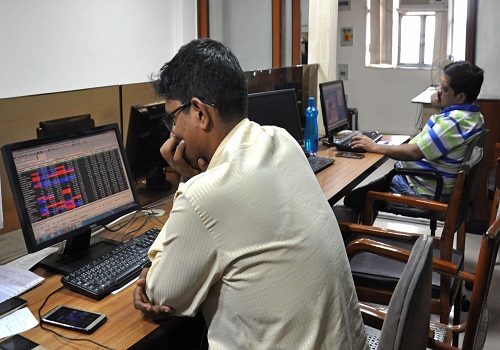Agri Commodity Technical Report 11 April 2025 - Geojit Financial Services Ltd

* Private weather forecaster Skymet has predicted a 'normal' southwest monsoon for India at 103% of the longperiod average, with an error margin of +/-5%. The season is likely to begin with relatively less rains, as the forecaster predicts rainfall in June at 96% of the long-period average. However, it is expected to increase from July, with rainfall during the month seen at 102%, that in August at 108%, and in September at 104%. According to Skymet Managing Director Jatin Singh, this season, the La Nina weather phenomenon has been weak and brief. "Vital signs of La Nina have started fading now. However, the occurrence of El Nino, which normally corrupts the monsoon, has been ruled out," he said in a statement. El Nino–Southern Oscillation-neutral is likely to be the most dominant category during the Indian summer monsoon, Singh said. The remnants of La Nina and ENSO-neutral together are likely to shield the monsoon from any egregious outcome. El Nino-Southern Oscillation refers to the fluctuation between El Nino and La Nina conditions in the Pacific Ocean. El Nino is linked to drier weather in India, while La Nina results in more favourable rainfall. The preliminary forecast of a positive Indian Ocean Dipole will work towards better monsoon prospects. The Indian Ocean Dipole is the difference in sea surface temperatures between the eastern and western tropical Indian Ocean. A negative Indian Ocean Dipole leads to less rainfall in India and vice versa. The prediction of another normal monsoon is likely to boost hope of robust kharif sowing in the coming season. India receives about 75% of its annual rainfall during the Jun-Sept period, making it crucial for sowing activities as well as reservoir replenishment.
* The sowing of summer crops in Maharashtra reached 436,368 hectares as of Apr. 1, up 30.4% on year from 334,562 hectares sown in the same period last year, according to a report by the state agriculture department. Maize acreage rose 92.6% on year to 79,169 hectares from 41,099 hectares last year.The area sown under paddy was 151,479 hectares, down from 156,208 hectares a year ago, the report showed. Acreage of bajra rose to 34,050 hectares from 29,609 hectares last year, while that of jowar also rose to 28,688 hectares from 22,624 hectares a year ago. The acreage under moong so far rose substantially to 15,729 hectares from 4,918 hectares last year, according to the report. Similarly, the area sown under urad was 1,402 hectares, up from 469 hectares a year ago. The total area sown under all oilseeds so far was 121,829 hectares, up from 77,723 hectares sown in the previous year. Under oilseeds, the acreage under groundnut rose to 87,392 hectares from 58,794 hectares last year. Summer crops are grown for a short period between the kharif and rabi seasons, with harvest taking place between April and May. Besides rice, sesame, and groundnut, the other major summer crops in the state include fruits and vegetables such as banana, pumpkin, and tomato. The water level in dams across Maharashtra was 43.7% of the live storage capacity as of Tuesday, compared with 36.7% a year ago, according to data from the state water resources department.
* The Securities and Exchange Board of India has extended the suspension of derivatives trade in wheat, chana, moong, paddy (non-basmati), mustard seeds and its derivatives, soya bean, and crude palm oil by another year, till Mar. 31, 2026, the regulator said in a release on Monday. In 2021, the government had imposed a ban on derivatives trading in the seven commodities for a year to check rising prices. The ban was extended consecutively each year till December 2024, and twice more till Mar. 31 this year.
* Farmers in Gujarat have sown summer crops across 1.13 million hectares as of Monday, up 1.7% from 1.11 million hectares a year ago, according to a report by the state agriculture department. Paddy acreage rose 34.8% on year to 126,606 hectares. The area under bajra was at 267,190 hectares, down from 305,183 hectares a year ago. On the other hand, the area under maize rose to 7,268 hectares from 6,872 hectares. Moong acreage rose to 57,513 hectares from 44,294 hectares a year ago, according to the report. Similarly, the area under urad was 30,017 hectares, up from 21,480 hectares a year ago. The area under groundnut was 53,335 hectares, down from 56,205 hectares a year ago, while that under sesame rose to 119,569 hectares from 113,435 hectares. The acreage of sugarcane rose to 10,884 hectares from 10,003 hectares a year ago, the report showed. The area under vegetables fell to 99,369 hectares from 101,266 hectares. Onion acreage so far was 10,934 hectares, against 10,852 hectares a year ago. In Gujarat, summer crops are sown in February and March, and harvested in May and June. Bajra, paddy, sesamum, and moong are the main crops grown in the state during the summer.


For More Geojit Financial Services Ltd Disclaimer https://www.geojit.com/disclaimer
SEBI Registration Number: INH200000345





















